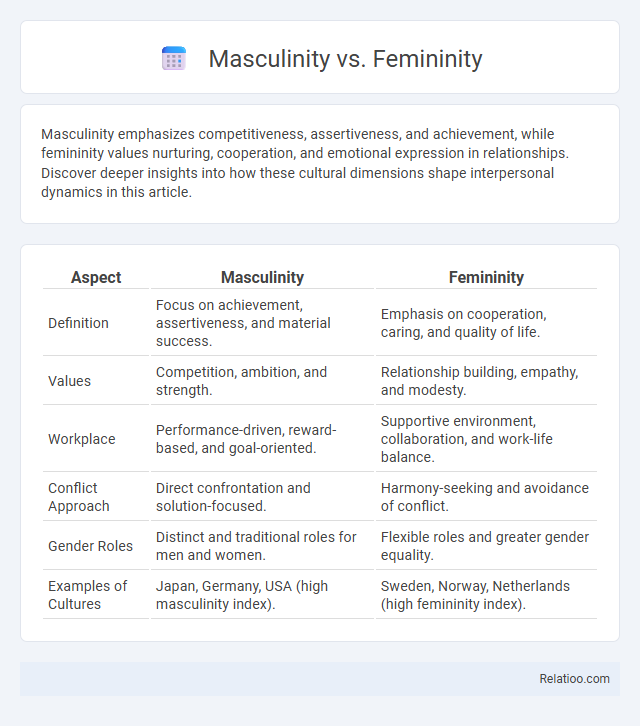Masculinity emphasizes competitiveness, assertiveness, and achievement, while femininity values nurturing, cooperation, and emotional expression in relationships. Discover deeper insights into how these cultural dimensions shape interpersonal dynamics in this article.
Table of Comparison
| Aspect | Masculinity | Femininity |
|---|---|---|
| Definition | Focus on achievement, assertiveness, and material success. | Emphasis on cooperation, caring, and quality of life. |
| Values | Competition, ambition, and strength. | Relationship building, empathy, and modesty. |
| Workplace | Performance-driven, reward-based, and goal-oriented. | Supportive environment, collaboration, and work-life balance. |
| Conflict Approach | Direct confrontation and solution-focused. | Harmony-seeking and avoidance of conflict. |
| Gender Roles | Distinct and traditional roles for men and women. | Flexible roles and greater gender equality. |
| Examples of Cultures | Japan, Germany, USA (high masculinity index). | Sweden, Norway, Netherlands (high femininity index). |
Defining Masculinity and Femininity
Masculinity is typically defined by traits such as assertiveness, strength, and independence, often linked to traditional male gender roles, while femininity encompasses qualities like empathy, nurturing, and emotional expressiveness, associated with traditional female gender roles. These definitions are culturally constructed and vary significantly across societies and historical periods, influencing individual behavior and social expectations. Understanding the distinction between masculinity and femininity is essential for analyzing gender role expectations and addressing challenges related to gender identity and equality.
Historical Perspectives on Gender Roles
Historical perspectives on gender roles reveal that masculinity and femininity have been culturally constructed to define societal expectations for men and women across civilizations. In many traditional societies, masculinity was associated with strength, protection, and leadership, while femininity emphasized nurturing, domestic responsibilities, and submissiveness. These gender role expectations have evolved but continue to influence contemporary social norms and behaviors, reflecting deep-rooted historical patterns.
Cultural Influences on Gender Identity
Cultural influences critically shape gender identity by defining masculinity and femininity through societal norms and expectations that vary widely across communities. These cultural frameworks dictate specific gender roles, impacting individuals' behavior, career choices, and emotional expression, often reinforcing traditional stereotypes. Understanding this dynamic is essential for addressing gender identity diversity and promoting inclusivity within different cultural contexts.
Psychological Traits of Masculinity and Femininity
Psychological traits of masculinity often emphasize assertiveness, independence, and competitiveness, reflecting societal expectations of strength and leadership. Femininity is typically associated with traits such as empathy, nurturing, and sensitivity, highlighting roles connected to caregiving and emotional support. These gender role expectations influence individual behavior and social interactions by shaping perceptions of appropriate emotional expression and decision-making styles.
Masculinity vs Femininity in Modern Society
Masculinity and femininity in modern society are increasingly understood as fluid constructs rather than fixed traits, challenging traditional gender role expectations. Social norms now emphasize emotional expression and nurturing qualities as acceptable for all genders, while valuing strength and independence without strict gender boundaries. This shift promotes greater equality by dismantling stereotypes that historically confined masculinity to dominance and femininity to passivity.
The Impact of Media on Gender Norms
Media shapes perceptions of masculinity and femininity by reinforcing traditional gender role expectations through repeated imagery and narratives, often limiting Your understanding of diverse identities. Television, films, and advertising frequently portray men as dominant and women as nurturing, embedding societal norms that influence behavior and self-expression. These portrayals solidify stereotypes, affecting individuals' confidence and challenging efforts toward gender equality.
Gender Expression and Social Expectations
Gender expression reflects individuals' outward behaviors, appearance, and mannerisms, shaped by societal expectations linked to masculinity and femininity. Social norms dictate distinct gender role expectations, often reinforcing stereotypes that associate masculinity with assertiveness and femininity with nurturing traits. These gendered expectations influence personal identity, social interactions, and cultural acceptance, impacting how individuals navigate their gender expression within varying contexts.
Challenging Gender Stereotypes
Challenging gender stereotypes involves questioning traditional masculinity and femininity norms that dictate rigid gender role expectations. Efforts to redefine these roles promote inclusivity by encouraging individuals to express diverse traits and behaviors regardless of their gender. This shift enhances social equity by dismantling biases linked to outdated gender constructs.
The Role of Masculinity and Femininity in Relationships
Masculinity and femininity significantly shape relationship dynamics by influencing communication styles, emotional expression, and conflict resolution strategies. Traditional masculine roles often emphasize assertiveness and independence, while feminine roles prioritize empathy and nurturing, impacting expectations and behaviors within partnerships. Understanding these gender role expectations allows couples to navigate differences, promote mutual respect, and foster balanced emotional support.
The Future of Gender Identity and Expression
Gender identity and expression are evolving beyond traditional masculinity and femininity frameworks, reflecting a future where rigid gender role expectations are increasingly challenged. You can expect more inclusive environments that embrace non-binary, gender-fluid, and diverse identities, promoting authentic self-expression without societal constraints. This shift fosters psychological well-being and social equity by dismantling stereotypes and expanding the understanding of gender as a spectrum rather than a binary concept.

Infographic: Masculinity vs Femininity
 relatioo.com
relatioo.com